Google’s dynamic algorithm when it comes to ranking websites on the SERPs remains a mystery. However, the right mix of relevant content, right keywords, and strong backlinks can help you climb up the ranking ladder. Moz carried out a search ranking factor study where it interviewed a substantial number of marketing experts. All of them said backlinks are the no.1 influencing factor affecting Google’s rankings. In this article, we will talk about backlinks and walk you through the process of monitoring them using BacklinkSEO. Besides being a backlink monitoring tool, it also helps you to plan and implement your link-building strategy.
If you already have background knowledge on backlinks, you may skip the first section and go straight to our tutorial on monitoring backlinks using BacklinkSEO

Put simply, backlinks are when one website links to another. An example of a backlink would be if Joe, who has a popular food blogging website, links to a multi-cuisine restaurant in the city when he writes a blog review. The link in Joe’s blog is a backlink to the restaurant’s website.
There are mainly two types of backlinks: no-follow and do-follow.
A no-follow backlink has a no-follow tag and carries less value than a do-follow backlink. According to WordStream, no-follow links do not increase your PageRank and its placement in the SERPs.
On the other hand, do-follow links can directly affect search engine rankings, which is why it is so highly sought after. Think of a do-follow backlink as a recommendation given from one site to another and a no-follow backlink as ‘Yeah, I know that organization but I haven’t really worked with them much, so I don’t know but I think they are good’.
It is a good idea to have a diversified backlink profile, i.e. a good mix of do-follow and no-follow links. You see, Google does not look at all do-follow links the same way. Not all of them will help improve your PageRank. If there are too many backlinks from the same domain, Google could look at it as spammy and give negative brownie points to your website. No-follow links can bring referral traffic to your website and are actually easier to get than do-follow links.
According to Neil Patel, when analyzing your backlinks, Google looks at:
If you don’t monitor your backlinks consistently, spammy backlinks can make their way into your backlink profile, resulting in a negative impact on your SEO. For example, while using the SEO services of a digital marketing agency, you might end up paying for them creating spammy backlinks to your website. Are you aware of this? If not, then that could be something you would want to look into. This is because Google’s penguin algorithm scans websites to identify spammy link structures, which may lead to penalization if you haven’t exercised due diligence when choosing a digital marketing agency.
Using a backlink monitoring tool such as BacklinkSEO can help you avoid misuse of your digital marketing budget by enabling you to check which links are do-follow, no-follow, sponsored and lost, etc. You also get a list of the domains from where your backlinks are coming in. So, if you see foreign language, adult sites, terms like gambling, websites using abusive language, and websites irrelevant to your niche, you need to get rid of them to prevent hampering your reputation.
Your competitors may resort to unethical ways of climbing up the SERPs by spamming your site through, for example, user-generated spam. If you are monitoring your backlinks regularly, you will be able to act before Google penalizes you. In addition, this process will enable you to identify reviews and complaints about your website so that you can understand what value these links are generating.
Check out this comprehensive article from BacklinkSEO on backlinks and why they are important from Backlinkseo to learn more.
Without further ado, let's look at the process of monitoring backlinks using BacklinkSEO.
First off, you will need to have an account on Backlinkseo. You will be required to sign up using your company’s or your own email address and name. Click on ‘Get Started’ to create an account.
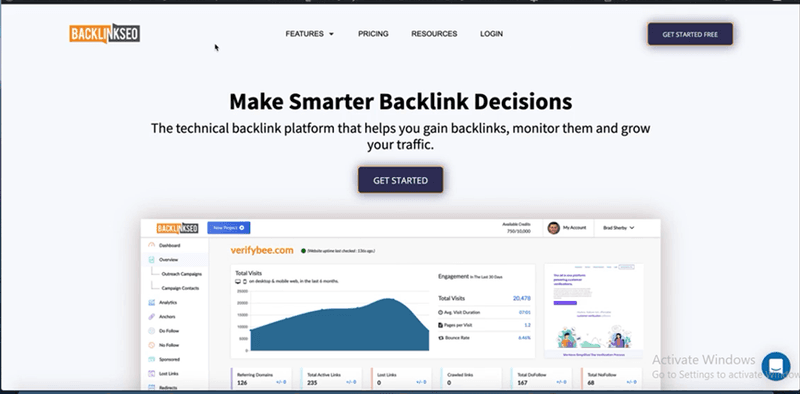
After you log in, the ‘Add a Domain’ option will appear. You will have to input the web address here.
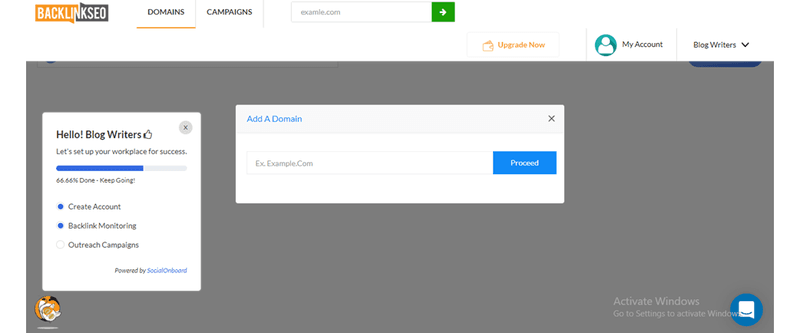
If you want to add additional domains, click on the ‘New Project’ icon located at the top right corner of the page:

Once you enter your domain, you’ll be asked if you want to use the BacklinkCrawler to find backlinks. Enter yes, and it will start finding backlinks for you.

Next, you will be asked to link your Google Analytics and Search Console account to import data regarding your web analytics so that BacklinkSEO can arrange important information such as click-through rates and other metrics that will give you an analytical view to your backlink profile, all in one place. Click, ‘Sync Now’. Then, choose your Google Analytics and Search Console account.

Next, this box will appear. If you already have a list of websites linking to yours, you can add them here. Also, if you feel that some backlinks are missing from the list of backlinks drawn up by BacklinkSEO, but you are aware that the websites are linking back to you, this option comes in handy. Then, you’ll be asked if you want to start the backlink crawling process. Click yes, then proceed.

The system will then crawl all the links on the pages in the list.
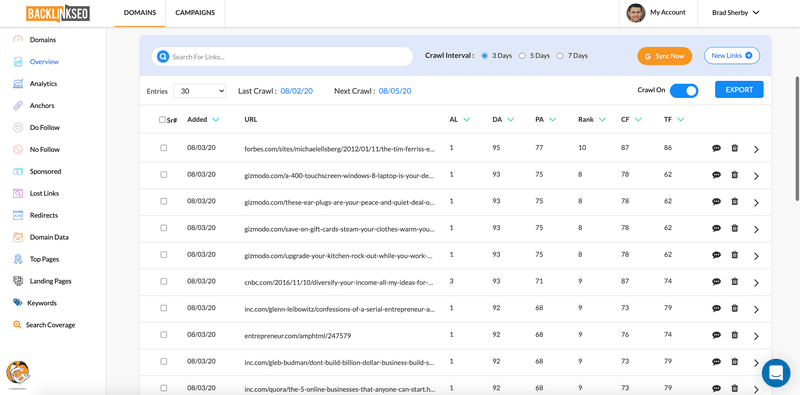
It is going to identify the following:
You can also choose how often you want the system to crawl your links so that you have an updated list. In the example above, it is set to 3 days.
This is divided into several sections. Here you can find analytics data on your website and backlinks. This data is key to monitoring your backlinks via BacklinkSEO.
Click on ‘Overview’ to navigate to your search insights. Here you will find your page view trends and how many referring domains (websites from which your web page has one or more backlinks), active links, lost links, etc. you have.
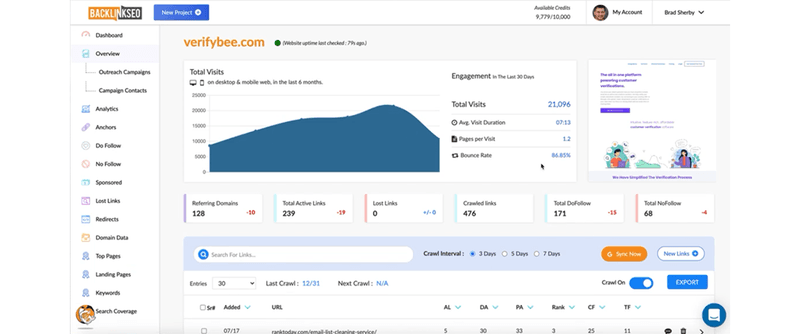
You can also add notes here to any backlink that may be of interest to those who are building or buying backlinks, such as the one below. However, do note that the practice of buying backlinks is not a sustainable measure to improve your rankings in the SERPs.
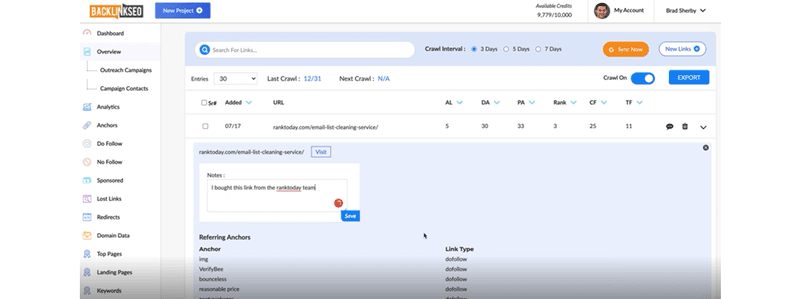
The Search Coverage feature takes in data from your search console and simplifies it for you to understand. You will be able to see how many clicks you receive, your CTR, number of impressions, and your overall position for different search terms. It will find these data for all the search terms that have been found. This will allow you to take steps to improve your content in the necessary areas.

In the example below, the click-through rate is below 1% while impressions are higher relatively. This means a lot of people are seeing it, but not clicking on it. The page that is coming up for this search term needs to be improved drastically, perhaps by changing the heading. Hence, this feature gives you a bird’s eye view of which content you can improve on without having to create new ones to improve your metrics.

Using the Keyword feature, you can find out more about your keywords and understand the amount of traffic different each keyword is bringing.
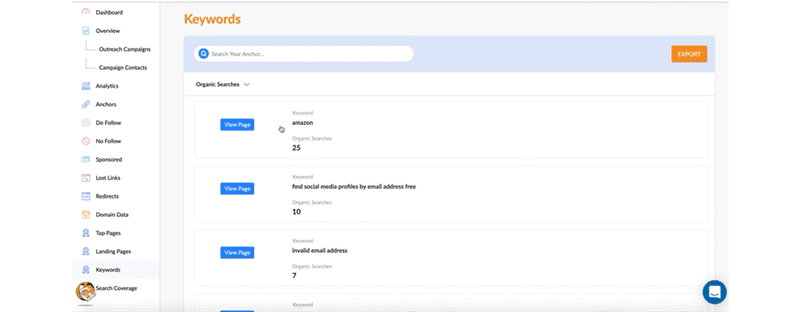
The Landing Pages feature allows you to find out the number of total users and new users of your landing pages. A Landing page is a page that your visitors see when they click on your site in the SERPs. You can also find out the bounce rate and take necessary steps accordingly. Bounce rate is defined as the percentage of visitors to a particular page who navigate away from the site after viewing only one page.
However, exercise caution when analyzing the bounce rate because sometimes, the bounce rate can be a conversion and Google just does not really understand that. Anytime a user either goes away from that page to another page, Google counts that into its bounce rate. So, you need to have other metrics in place alongside to identify which are bounces and which are not. The Landing Page gives you a really good starting point to do that.

In this section, you can find all the pages ranked in terms of the number of backlinks they have. For each backlink, you will find the Anchor (the clickable text in a hyperlink), the domain authority (DA), and the page authority (PA) and therefore, be more informed about the quality of the backlinks. Low-quality backlinks do not really help with rankings and could even lead to penalization. So, this feature enables you to keep a track of that.

Domain data is basically a spread of all the referring domain and domain types. Too many backlinks coming in from the same domain could be interpreted as spammy by Google, so this feature acts as a reference point for this.
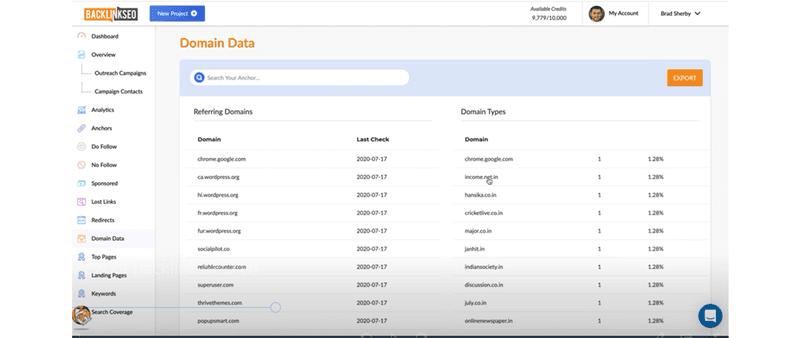
Therefore, following the aforementioned steps can help you keep a grip on and monitor your backlinks using BacklinkSEO. However, this is a continuous process, so make sure you are doing this regularly to get the best results.
You can check out these resources at BacklinkSEO to help you devise your link-building strategy.